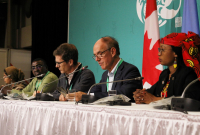Support strong Canadian climate journalism for 2025
Civil society has a message for COP negotiators: let Indigenous nations lead on the world’s biodiversity crisis.
On Saturday afternoon in Montréal, the home of COP15 negotiations, over 3,500 people, including environmentalists, union representatives and Iranian demonstrators marched behind Indigenous leaders. The demonstrators made their way from the base of Mont Royal and concluded at the Parterre in the Quartier des spectacles, a park around the corner from where COP15 negotiations were taking place.

Having Indigenous leaders front the march was a deliberate choice to drive home a message Indigenous sovereignty rights and title must be included in the finalized COP15 agreement’s targets. Research has shown 80 per cent of the world’s biodiversity is on lands inhabited by Indigenous Peoples.
In the early morning hours on Saturday, there was a big win for Indigenous Peoples in negotiations, Swetha Stotra Bhashyam of Global Youth Biodiversity Network and based in India told Canada’s National Observer. Global Youth Biodiversity Network are involved in negotiations.
“They did include environmental defenders' rights in the targets.”

The Nairobi negotiations held earlier this year in June ended with “literally 1,800 brackets,” Bhashyam said. A bracket in COP negotiations are items left for nations to debate and negotiate; once an item leaves a bracket, it becomes a target in the finalized agreeement.
The big joke coming out of the Nairobi negotiations was that the “global biodiversity framework” should have been named the “global bracketed framework,” Bhashyam added.
COP agreements are similar to co-drafting a work document with colleagues. But instead of having a department of four to argue over wording, COP negotiations have over 190 nations that debate and prune each word and turn of phrase.
It’s a slow and deliberate process because every word informs the next 10 years of global biodiveristy action.

It’s a difficult fight for groups like the Global Youth Biodiversity which works tirelessly to enshrine human rights into the final wording of the agreement targets. Without specific language in the targets, many countries, including India, will not implement them, Bhashyam explained.
Over the next week of negotiations, battles remain over targets around Indigenous sovereignty and self-governance, and free prior and informed consent.
That was why Collectif COP15, a coalition of civil society groups, ensured Indigenous leaders led the march.

The march concluded with speeches by Indigenous and environmental leaders.
“We want one thing, we want Canada and all of these companies out of Indigenous land,” one Indigenous youth said to the crowd.
Bhashyam argues many nations think in archaic terms and are too scared to touch the social causes of the biodiversity crisis. They forget the root causes of the current crisis are the “values and behaviours that we hold,” she added.

“That’s why it’s important for us to use these marches as a space to show them people are ready for change, and that you are the ones too scared to make that change.”
Matteo Cimellaro / Canada’s National Observer / Local Journalism Initiative
The previous estimation of demonstrators at the march was over 1,000. The updated numbers are over 3,500.







Comments